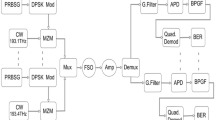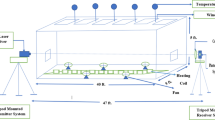Abstract
On the “Free Space Optical” (FSO) communication link, the atmospheric scintillation phenomena play a crucial role. The severity of the scintillation can seriously impair the FSO link’s performance. In this article, we consider two wavelengths of FSO link, visible (638 nm) and infrared (980 nm), and measure their performances in a developed artificial scintillation simulation chamber, with the severity of scintillation ranged from low to high. The link performance is measured in terms of the eye pattern, optical power attenuation, signal-to-noise ratio (SNR), bit error rate (BER), etc., at the receiver side signal. As compared to the visible wavelength, 980 nm produces favorable performance in the high scintillation regime.
Similar content being viewed by others
References
A. K. Majumdar and J. C. Ricklin, Free-Space Laser Communications: Principles & Advances, Springer Science & Business Media (2007).
P. Kaur, V. K. Jain, and S. Kar, “BER performance improvement of FSO links with aperture averaging and receiver diversity technique under various atmospheric conditions,” in: 9th International Conference on Industrial and Information Systems (ICIIS), Gwalior, India, 1 (2014); DOI: https://doi.org/10.1109/ICIINFS.2014.7036552
Y. Wang, Q. Zhang, J. Ma, and Q. Yang, J Russ. Laser Res., 34, 247 (2013).
S. Mukherjee, B. Das, and S. Mazumdar, “Experimental studies of laser power attenuation of 532 nm laser at different visibility using simulated foggy conditions,” AIP Conf. Proc., 2640, 020029 (2022); DOI: https://doi.org/10.1063/5.0110220
J. Wang, J. Ma, Y. Song, et al., J. Russ. Laser Res., 33, 379 (2012).
W. Du, Q. Yuan, X. Cheng, et al., J. Russ. Laser Res., 42, 198 (2021).
Z. Ghassemlooy, W. Popoola, and S. Rajbhandari, Optical Wireless Communications - System and Channel Modelling with MATLAB, CRC Press, USA (2012).
X. Zhu and J. M. Kahn, IEEE Trans. Commun., 50, 1293 (2002).
Priyanka, M. L. Singh, H. S. Gill, et al., Wireless Personal Communications, 113, 2403 (2020).
H. Kaushal, V. Kumar, A. Dutta, et al., IEEE Photonics Technol. Lett., 23, 1691 (2011).
X. Qiang, Y. Li, F. Zong, and J. Zhao, “Measurement of laboratory-simulated atmospheric turbulence by PSD,” in: 9th International Conference on Electronic Measurement & Instruments, 2009, Beijing, China (2009), p. 2-90-2-94; DOI: https://doi.org/10.1109/ICEMI.2009.5274415.
L. C. Andrew, R. L. Phillips, and C. Y. Hopen, Laser Beam Scintillation with Applications, SPIE (2001); DOI: https://doi.org/10.1117/3.412858
S. S. Muhammad, P. Kohldorfer, and E. Leitgeb, “Channel modelling for terrestrial free space optical links, in: Proceedings of the 7th International Conference Transparent Optical Networks, 2005, Barcelona, Spain, 1, p. 407 (2005); DOI: https://doi.org/10.1109/ICTON.2005.1505832.
S. K. Mandal, B. Bera, and G. G. Dutta, “Free Space Optical (FSO) communication link design under adverse weather condition,” in: 2020 International Conference on Computer, Electrical & Communication Engineering (ICCECE), Kolkata, India (2020), p. 1; DOI: https://doi.org/10.1109/ICCECE48148.2020.9223023
V. Mackowiak, J. Peupelmann, Y. Ma, and A. Gorges, Noise Equivalent Power, Whitepaper, Thorlabs (2015).
Author information
Authors and Affiliations
Corresponding author
Rights and permissions
Springer Nature or its licensor (e.g. a society or other partner) holds exclusive rights to this article under a publishing agreement with the author(s) or other rightsholder(s); author self-archiving of the accepted manuscript version of this article is solely governed by the terms of such publishing agreement and applicable law.
About this article
Cite this article
Mukherjee, S., Paul, S. & Mazumdar, S. Experimental Studies of the Influence of Scintillation on a FSO Communication System for Visible and Infrared Wavelengths. J Russ Laser Res 44, 357–364 (2023). https://doi.org/10.1007/s10946-023-10141-x
Received:
Published:
Issue Date:
DOI: https://doi.org/10.1007/s10946-023-10141-x




